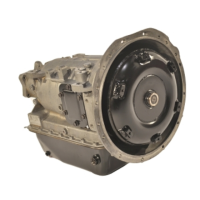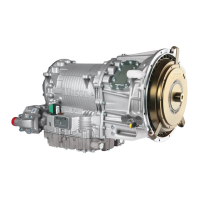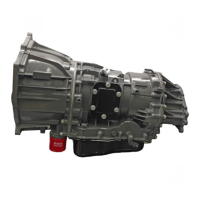2–8 Copyright © 1996 General Motors Corp.
AT 500, 1500 SERIES AUTOMATIC TRANSMISSIONS
valve, balanced with hydraulic pressure above the
valve, creates a regulated main pressure.
(2) The main-pressure circuit to the remain-
der of the hydraulic system is connected to the main-
pressure regulator valve bore at the same point as the
pump outlet. Before S/N 34501 (AT 540, 543 models),
main pressure is directed to seven points in the system.
These are the 3–4 shift signal valve, 2–3 shift signal
valve, 1–2 shift signal valve, selector valve, 1–2 relay
valve, modulator valve, and governor valve. After S/
N 34500 (AT 540, 543 models) and for all other AT
models, the trimmer regulator valve and the priority
valve are also in the main-pressure circuit.
(3) Although main pressure is controlled pri-
marily by the force of the spring below the regulator
valve, modulator pressure (earlier models), and for-
ward regulator pressure reduce main pressure.
(4) On AT 542, 543, 545, 1542, and 1545
models, main pressure remains constant because there
is no modulated pressure at the main-pressure regula-
tor valve.
e. Converter-In (Yellow), Converter-Out
(Orange), Lubrication (Green) Circuits
(1) Converter-in fluid flows through the
torque converter continuously to keep it filled and to
carry off the heat generated in the converter.
(2) Converter-out fluid, leaving the torque
converter, flows to an external cooler (supplied by the
vehicle or power unit manufacturer). A flow of air or
water over or through the cooler removes the heat
from the transmission fluid.
(3) Cooler-out fluid returns to components
requiring continuous flow lubrication. Lubrication
fluid then returns to the sump.
f. Selector Valve, Neutral, Forward Regulator
Circuit (Orange and Yellow)
(1) The selector valve is manually shifted to
select the operating range desired. The selector valve
establishes the hydraulic circuit for operation in the
range selected. Shifting within any range is automatic,
depending upon speed and throttle position.
(2) Neutral, forward regulator pressure is di-
rected from the selector valve to the main-pressure
regulator valve when the selector valve is at any posi-
tion except reverse. In neutral and in all forward
ranges, this pressure pushes downward on the main-
pressure regulator valve and reduces main pressure. In
reverse, regulator pressure is absent, permitting a
higher main pressure.
g. Governor Valve, Governor Circuit
(Green and White)
(1) Governor feed is main pressure directed
to the governor valve. The governor controls the po-
sition of the governor valve, which determines the
pressure in the governor circuit. When the trans-
mission output is not rotating, governor pressure is
approximately 2 psi (14 kPa). When the transmis-
sion output rotates, governor pressure varies with
the speed of rotation. The greater the speed of rota-
tion, the greater the governor pressure.
(2) Governor pressure is directed to the 1–2,
2–3, and 3–4 shift valves.
h. Modulator Pressure Circuit (Red and Green)
(1) Modulator pressure is a regulated, re-
duced pressure derived from main pressure at the mod-
ulator valve. Pressure is applied by either a vacuum
modulator or a mechanical actuator. At high vacuum
(closed throttle), all pressure is removed from the actu-
ator pin allowing the valve to move rightward. Low
vacuum (open throttle) increases the pressure on the
actuator pin, due to the spring force in the vacuum
modulator, moving the valve leftward.
(2) When the modulator pressure valve
moves to the left, modulator pressure is reduced; when
it moves to the right, modulator pressure is increased.
Since engine vacuum varies with load, throttle open-
ing, and engine speed, the position of the modulator
pressure valve, and modulator pressure vary also. On
the AT 542, 543, 545, 1542, and 1545 models, this
varying pressure is directed to the three shift signal
valves and to the trimmer regulator valve. On the AT
540, modulated pressure is directed also to the main-
pressure regulator valve.
(3) At the 1–2, 2–3, and 3–4 shift signal
valves, modulator and governor pressures act to up-
shift the valves in proper sequence. At a given gover-
nor pressure, the introduction of modulator pressure
upshifts a signal valve. A decrease or removal of mod-

